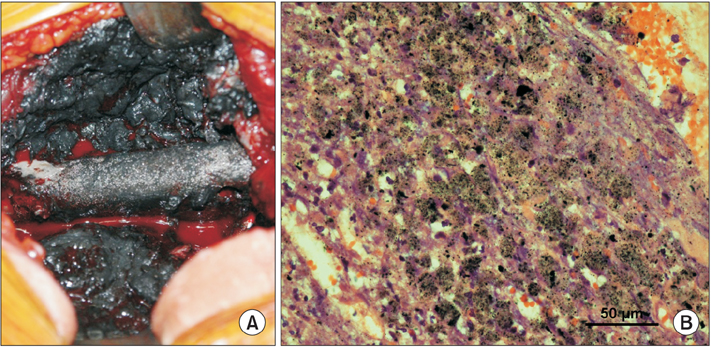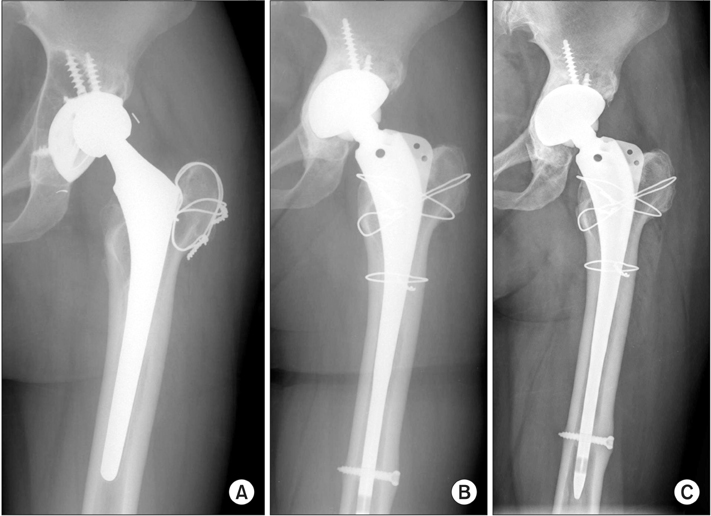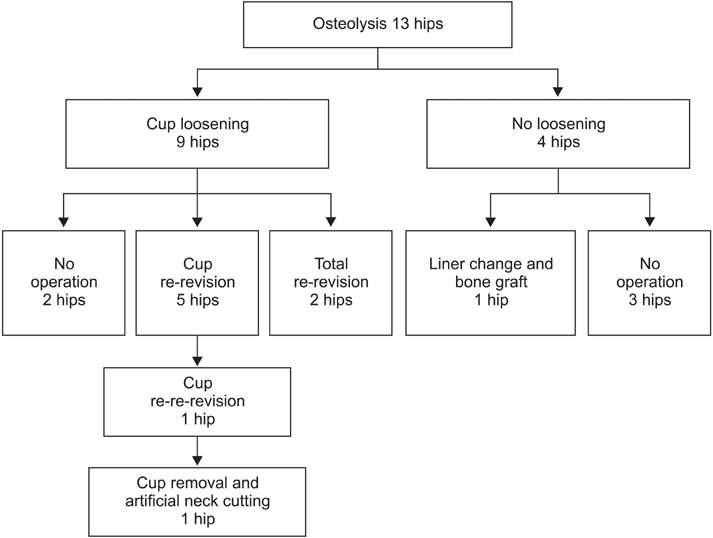Clin Orthop Surg.
2015 Mar;7(1):46-53. 10.4055/cios.2015.7.1.46.
The Result of Revision Total Hip Arthroplasty in Patients with Metallosis Following a Catastrophic Failure of a Polyethylene Liner
- Affiliations
-
- 1Department of Orthopedic Surgery, Joint and Spine Center, SMG-SNU Boramae Medical Center, Seoul National University College of Medicine, Seoul, Korea.
- 2Department of Orthopedic Surgery, Seoul National University College of Medicine, Seoul, Korea. jjyos@snu.ac.kr
- 3Department of Orthopedic Surgery, Seoul National University Bundang Hospital, Seongnam, Korea.
- 4Medical Research Center, Seoul National University, Seoul, Korea.
- KMID: 2069874
- DOI: http://doi.org/10.4055/cios.2015.7.1.46
Abstract
- BACKGROUND
Wear cannot be completely prevented after total hip arthroplasty. If severe polyethylene (PE) liner wear develops, the so-called catastrophic failure occurs and metallosis develops. We postulated that longevity of the new implant may be affected after revision surgery for metallosis following a catastrophic failure of a PE liner due to the substantial amount of PE wear particles and infiltration of the metal particles in this catastrophic condition.
METHODS
Twenty-three hips of 23 patients were identified because they showed metallosis during revision total hip arthroplasties performed in Seoul National University Hospital between January 1996 and August 2004. They were followed for at least 6.5 years after the index revision total hip arthroplasty. The clinical and radiological results of revision total hip arthroplasties in these patients were evaluated.
RESULTS
The median Harris hip score increased from 60 points before revision total hip arthroplasties to 90 points at the final follow-up. Osteolysis was detected at an average of 9.3 years after revision total hip arthroplasties in 13 hips and acetabular cup loosening at average 9.8 years after revision total hip arthroplasties in 9 hips. With radiographic evidence of osteolysis and loosening as the end points, the 15-year survival rates were 28.2% and 56.0%, respectively.
CONCLUSIONS
The survival rate of revision total hip arthroplasty in patients with metallosis following a catastrophic failure of a PE liner was low.
MeSH Terms
-
Adolescent
Adult
*Arthroplasty, Replacement, Hip
Biocompatible Materials
Female
Hip Joint/radiography/surgery
Hip Prosthesis/*adverse effects
Humans
Joint Diseases/radiography/*surgery
Male
Metals/adverse effects
Metals, Heavy/*poisoning
Middle Aged
Osteolysis/etiology/surgery
Poisoning/etiology/*surgery
Polyethylene/adverse effects
Prosthesis Design
*Prosthesis Failure/etiology
Reoperation
Young Adult
Biocompatible Materials
Metals
Metals, Heavy
Polyethylene
Figure
Reference
-
1. Yoon PW, Kim JI, Kim DO, et al. Cementless total hip arthroplasty for patients with Crowe type III or IV developmental dysplasia of the hip: two-stage total hip arthroplasty following skeletal traction after soft tissue release for irreducible hips. Clin Orthop Surg. 2013; 5(3):167–173.
Article2. Clohisy JC, Calvert G, Tull F, McDonald D, Maloney WJ. Reasons for revision hip surgery: a retrospective review. Clin Orthop Relat Res. 2004; (429):188–192.3. Nam KW, Yoo JJ, Kim YL, Kim YM, Lee MH, Kim HJ. Alumina-debris-induced osteolysis in contemporary aluminaon-alumina total hip arthroplasty: a case report. J Bone Joint Surg Am. 2007; 89(11):2499–2503.
Article4. Park SK, Kim YG, Kim SY. Treatment of periprosthetic femoral fractures in hip arthroplasty. Clin Orthop Surg. 2011; 3(2):101–106.
Article5. Elsner JJ, Shemesh M, Mezape Y, et al. Long-term evaluation of a compliant cushion form acetabular bearing for hip joint replacement: a 20 million cycles wear simulation. J Orthop Res. 2011; 29(12):1859–1866.
Article6. Esposito CI, Walter WL, Roques A, et al. Wear in aluminaon-alumina ceramic total hip replacements: a retrieval analysis of edge loading. J Bone Joint Surg Br. 2012; 94(7):901–907.7. Chang JD, Lee SS, Hur M, Seo EM, Chung YK, Lee CJ. Revision total hip arthroplasty in hip joints with metallosis: a single-center experience with 31 cases. J Arthroplasty. 2005; 20(5):568–573.8. Donaldson JR, Miles J, Sri-Ram K, Poullis C, Muirhead-Allwood S, Skinner J. The relationship between the presence of metallosis and massive infection in metal-on-metal hip replacements. Hip Int. 2010; 20(2):242–247.
Article9. Khan RJ, Wimhurst J, Foroughi S, Toms A. The natural history of metallosis from catastrophic failure of a polyethylene liner in a total hip. J Arthroplasty. 2009; 24(7):1144.e1–1144.e4.
Article10. Wooley PH, Morren R, Andary J, et al. Inflammatory responses to orthopaedic biomaterials in the murine air pouch. Biomaterials. 2002; 23(2):517–526.
Article11. Spicka J, Gallo J, Cechova I, Kaminek P, Mikulik J. Surgical therapy of osteolysis around stable cementless hip arthroplasty. Acta Chir Orthop Traumatol Cech. 2005; 72(4):228–234.12. Su EP, Callander PW, Salvati EA. The bubble sign: a new radiographic sign in total hip arthroplasty. J Arthroplasty. 2003; 18(1):110–112.13. D'Antonio J, McCarthy JC, Bargar WL, et al. Classification of femoral abnormalities in total hip arthroplasty. Clin Orthop Relat Res. 1993; (296):133–139.14. D'Antonio JA, Capello WN, Borden LS, et al. Classification and management of acetabular abnormalities in total hip arthroplasty. Clin Orthop Relat Res. 1989; (243):126–137.15. Joshi RP, Eftekhar NS, McMahon DJ, Nercessian OA. Osteolysis after Charnley primary low-friction arthroplasty: a comparison of two matched paired groups. J Bone Joint Surg Br. 1998; 80(4):585–590.16. Maloney WJ, Jasty M, Harris WH, Galante JO, Callaghan JJ. Endosteal erosion in association with stable uncemented femoral components. J Bone Joint Surg Am. 1990; 72(7):1025–1034.
Article17. Harris WH. Traumatic arthritis of the hip after dislocation and acetabular fractures: treatment by mold arthroplasty: an end-result study using a new method of result evaluation. J Bone Joint Surg Am. 1969; 51(4):737–755.
Article18. Martell JM, Pierson RH 3rd, Jacobs JJ, Rosenberg AG, Maley M, Galante JO. Primary total hip reconstruction with a titanium fiber-coated prosthesis inserted without cement. J Bone Joint Surg Am. 1993; 75(4):554–571.
Article19. Schmitz MW, Busch VJ, Gardeniers JW, Hendriks JC, Veth RP, Schreurs BW. Long-term results of cemented total hip arthroplasty in patients younger than 30 years and the outcome of subsequent revisions. BMC Musculoskelet Disord. 2013; 14:37.20. Yoo JJ, Yoon PW, Lee YK, Koo KH, Yoon KS, Kim HJ. Revision total hip arthroplasty using an alumina-on-alumina bearing surface in patients with osteolysis. J Arthroplasty. 2013; 28(1):132–138.
Article21. Skoglund B, Aspenberg P. PMMA particles and pressure: a study of the osteolytic properties of two agents proposed to cause prosthetic loosening. J Orthop Res. 2003; 21(2):196–201.
Article22. Campbell P, Shimmin A, Walter L, Solomon M. Metal sensitivity as a cause of groin pain in metal-on-metal hip resurfacing. J Arthroplasty. 2008; 23(7):1080–1085.
Article23. Grammatopoulos G, Pandit H, Kamali A, et al. The correlation of wear with histological features after failed hip resurfacing arthroplasty. J Bone Joint Surg Am. 2013; 95(12):e81.
Article24. Kwon YM, Xia Z, Glyn-Jones S, Beard D, Gill HS, Murray DW. Dose-dependent cytotoxicity of clinically relevant cobalt nanoparticles and ions on macrophages in vitro. Biomed Mater. 2009; 4(2):025018.25. Pandit H, Glyn-Jones S, McLardy-Smith P, et al. Pseudotumours associated with metal-on-metal hip resurfacings. J Bone Joint Surg Br. 2008; 90(7):847–851.
Article
- Full Text Links
- Actions
-
Cited
- CITED
-
- Close
- Share
- Similar articles
-
- Failure of a Metal Femoral Head after Revision Total Hip Arthroplasty for a Ceramic Liner Fracture
- Failure Mode of Polyethylene Liner in Total Hip Arthroplasty with Harris-Galante II Acetabular Cup
- Ceramic Head Fracture in Ceramic-on-Polyethylene Total Hip Arthroplasty
- Bilateral Catastrophic Acetabular Component Failure after Ceramic-on-Polyethylene Total Hip Arthroplasty: A Case Report
- Metallosis after Revision of a Fractured Ceramic Head onto a Metal-on-Polyethylene Articulation: A Case Report






